The Development of Portraiture in Muscovy
Formal painting in Medieval Russia was first and foremost confined to
religious themes. The activity of painters and mosaicists consisted in following as
closely as possible what were considered to be divinely inspired model, a substantial
repertoire of which was available in Byzantium. Painters were to follow the
acceptable iconography for multi-figured compositions and the standard representations of
individual saints; creativity was not a measure of artistic success. While no early
examples have been preserved, there is reason to believe that books with sketches of the
standard iconography were available; in their absence, presumably a beginning artist would
learn the iconography during his apprenticeship to a master painter. Certainly a
great many, if not most of the icon painters in Medieval Russia were themselves monks.
As is well documented, however, formal painting could depict
"secular" scenes--witness the stairwell frescoes in the Cathedral of Sancta
Sophia in Kiev, which are devoted to the entertainments of the princely court.
Furthermore, living members of the princely family could be depicted as patrons of the
church-- in the frescoes or mosaics of a church, in icons, or in the frontispiece of a
manuscript. Down through the centuries, there are numerous examples of laymen
participating in acts of worship. The "dedication" fresco of Iaroslav the
Wise and his family in the Cathedral of Sancta Sophia in Kiev is the earliest example from
Rus. Later, a noteworthy example is the "praying Novgorodians" occupying
the lower register of a two-tiered icon, where they are praying to the deisis above.
The sixteenth-century Muscovite icon of the "Blessed Host" showing the
victorious procession of live soldiers and princes accompanied by those who died in the
siege of Kazan is another example, in which it is significant that the figure assumed to
be Tsar Ivan IV bears a cross. There is ample evidence both in miniature painting
and in icons that artists drew upon real-life observation. However, the tendency was
toward stylization, and the Orthodox norms dictated against "realism."
Illuminated manuscripts came by the Muscovite period to be the principal medium for
depicting "secular" scenes; however, the miniaturists also inclined toward very
stylized representations, preserving to a considerable degree Byzantine strictures
regarding two-dimensionality. The idea of painting portraits of living individuals,
which became common in the Renaissance in the West, was very slow to catch on in Russia.
Muscovite princes, diplomats and courtiers obviously made the acquaintance
of Western portraiture. We know certainly that by the time of Ivan IV, when he was
fishing for an advantageous foreign marriage, he ordered his ambassador to obtain a
portrait (parsuna) of the prospective bride. There is little evidence,
however, that portraiture became acceptable in Muscovy before the second half of the
seventeenth century.
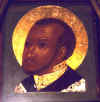 We can
begin to speak of "icon-portraits" possibly by ca. 1600. While the
versions we have tend to be copies made no earlier than the end of the seventeenth
century, it is argued that they are based on originals which may have been painted not
long after the deaths of those depicted. One such example is an icon-portrait of
Tsar Fedor Ivanovich (the last of the Moscow branch of the Riurikids who died in 1598),
who was known for his piety and was venerated, if not actually canonized, as a
saint. The main thing which would distinguish him from an ascetic saint is his
jeweled collar. Otherwise, we see the typical iconographic facial features,
including stylized almond-shaped eyes, and a somewhat pinched, ascetic mouth.
We can
begin to speak of "icon-portraits" possibly by ca. 1600. While the
versions we have tend to be copies made no earlier than the end of the seventeenth
century, it is argued that they are based on originals which may have been painted not
long after the deaths of those depicted. One such example is an icon-portrait of
Tsar Fedor Ivanovich (the last of the Moscow branch of the Riurikids who died in 1598),
who was known for his piety and was venerated, if not actually canonized, as a
saint. The main thing which would distinguish him from an ascetic saint is his
jeweled collar. Otherwise, we see the typical iconographic facial features,
including stylized almond-shaped eyes, and a somewhat pinched, ascetic mouth.
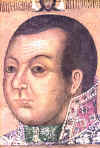 Another
example of an "icon-portrait" is this image of one of the heroes of the Time of
Troubles, Prince Mikhail Skopin-Shuiskii, who died somewhat mysteriously at a young age in
1610 (possibly eliminated as a potential rival to the throne?) and thus perhaps came to be
venerated in the same way that Russians tended to venerate other innocent princely victims
such as Boris and Gleb, the first Russian saints. In the case of the Skopin-Shuiskii
picture, there is no halo, and his jeweled collar is particularly prominent.
However, at the top of the picture is an image of the "Savior Not Made By
Hands"; the facial features of the prince show some of the iconographic cliches, even
though his chubby face and snazzy crew-cut might be taken to suggest something of the real
person.
Another
example of an "icon-portrait" is this image of one of the heroes of the Time of
Troubles, Prince Mikhail Skopin-Shuiskii, who died somewhat mysteriously at a young age in
1610 (possibly eliminated as a potential rival to the throne?) and thus perhaps came to be
venerated in the same way that Russians tended to venerate other innocent princely victims
such as Boris and Gleb, the first Russian saints. In the case of the Skopin-Shuiskii
picture, there is no halo, and his jeweled collar is particularly prominent.
However, at the top of the picture is an image of the "Savior Not Made By
Hands"; the facial features of the prince show some of the iconographic cliches, even
though his chubby face and snazzy crew-cut might be taken to suggest something of the real
person.
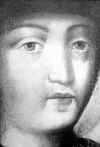 During
the seventeenth century the practice developed of placing icon-portraits of deceased
princes next to their tombs in the Cathedral of the Archangel Michael in the Kremlin.
One such picture which has been preserved is a full-length image of Tsar Fedor
Alekseevich (ruled 1676-1682), a picture presumably painted posthumously. This
detail of the face shows that some of the iconographic cliches have been retained (notably
in the line of the nose and the small mouth) but that stylistic elements of
"realistic portraiture" have been introduced--notably in the eyes and the
tendency to substantial shading to suggest three-dimensionality of the face. By the
time this picture was painted in the mid-1680s, western art was well known in Muscovite
elite circles, some of the painters in the Kremlin workshops were able to produce work
incorporating elements of Western style, and there were as well a few foreign artists who
seem to have been employed at court.
During
the seventeenth century the practice developed of placing icon-portraits of deceased
princes next to their tombs in the Cathedral of the Archangel Michael in the Kremlin.
One such picture which has been preserved is a full-length image of Tsar Fedor
Alekseevich (ruled 1676-1682), a picture presumably painted posthumously. This
detail of the face shows that some of the iconographic cliches have been retained (notably
in the line of the nose and the small mouth) but that stylistic elements of
"realistic portraiture" have been introduced--notably in the eyes and the
tendency to substantial shading to suggest three-dimensionality of the face. By the
time this picture was painted in the mid-1680s, western art was well known in Muscovite
elite circles, some of the painters in the Kremlin workshops were able to produce work
incorporating elements of Western style, and there were as well a few foreign artists who
seem to have been employed at court.
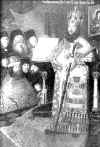 One of
the best known of the Muscovite portraits depicts Patriarch Nikon and a group of
clerics. Like the picture of Fedor Alekseevich, it is probably a posthumous
"portrait," and dates from the middle of the 1680s. Possibly the painting
was commissioned by the tsarevna Tat'iana Mikhailovna on the occasion of the
dedication of the important Cathedral of the Resurrection whose construction in the New
Jerusalem Monastery had begun under its chief patron, Nikon. One reason for assuming
this is that the clerics shown and identified in the inscriptions were active at the
monastery during different periods of Nikon's life. One assumes, therefore, that the
faces were not painted from life. If these assumptions about the date and
purpose of the painting are correct, then we should not look on it so much as a portrait
but rather as a commemoration of individuals for their particular contributions to the
Church and the faith. At the same time, if this picture was produced soon after a
hagiographic "life" of Nikon was produced in the early 1680s, it may represent
an effort by those who admired the deposed patriarch to elevate his standing in the eyes
of posterity--that is, a response to the fact that he had been removed from his office as
a consequence of his quarrel with Tsar Aleksei Mikhailovich.
One of
the best known of the Muscovite portraits depicts Patriarch Nikon and a group of
clerics. Like the picture of Fedor Alekseevich, it is probably a posthumous
"portrait," and dates from the middle of the 1680s. Possibly the painting
was commissioned by the tsarevna Tat'iana Mikhailovna on the occasion of the
dedication of the important Cathedral of the Resurrection whose construction in the New
Jerusalem Monastery had begun under its chief patron, Nikon. One reason for assuming
this is that the clerics shown and identified in the inscriptions were active at the
monastery during different periods of Nikon's life. One assumes, therefore, that the
faces were not painted from life. If these assumptions about the date and
purpose of the painting are correct, then we should not look on it so much as a portrait
but rather as a commemoration of individuals for their particular contributions to the
Church and the faith. At the same time, if this picture was produced soon after a
hagiographic "life" of Nikon was produced in the early 1680s, it may represent
an effort by those who admired the deposed patriarch to elevate his standing in the eyes
of posterity--that is, a response to the fact that he had been removed from his office as
a consequence of his quarrel with Tsar Aleksei Mikhailovich.
 Stylistically,
the picture is a somewhat awkward amalgam of iconographic convention and western
realism. The faces of the clerics are individualized. At the same time, the
artist deliberately avoided conveying a real sense of depth and three dimensionality in
the picture. This is particulary evident in the fact that the second row of the
clerics is no smaller than the "front" row and is perched right on top of
them. This spatial arrangment is typical in icons that adhere to Byzantine
conventions, in which figures that in "real space" would be in different planes
are depicted as being in a single plane, with their separation denoted by their vertical
placement relative to each other.
Stylistically,
the picture is a somewhat awkward amalgam of iconographic convention and western
realism. The faces of the clerics are individualized. At the same time, the
artist deliberately avoided conveying a real sense of depth and three dimensionality in
the picture. This is particulary evident in the fact that the second row of the
clerics is no smaller than the "front" row and is perched right on top of
them. This spatial arrangment is typical in icons that adhere to Byzantine
conventions, in which figures that in "real space" would be in different planes
are depicted as being in a single plane, with their separation denoted by their vertical
placement relative to each other.
One of the important sources we can tap for trying to learn whether
Muscovite cultural attitudes changed as a result of exposure to the west is the accounts
of ambassadors who traveled abroad. Unfortunately, all too often their reports,
which followed stylized official guidelines, are not very revealing. We find
Muscovite ambassadors attending plays by Shakespeare and Moliere; yet they do not record
their impressions, and we have to wonder whether they were aware of the significance of
what they were seeing. It is at least likely that some of the more significant
impressions were related orally but simply had no place in the official written records of
the embassies. Certainly there has to have been some impact of embassies on the
tastes of the Muscovite elite. We know that ambassadors sat 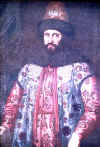 for potraits, and we have inventories
of household possessions of the Muscovite elite in the second half of the seventeenth
century which include portraits. One ambassador who sat for a portrait was I. I.
Chemodanov, sent to Venice in 1657. The original of his picture hangs today in the
Uffizi Gallery in Florence. He is shown in his formal brocaded robe and fur-trimmed
cap, looking just as we would expect a member of the traditional Muscovite boyar elite to
look. Chemodanov seems to have received an appeal from the local Orthodox
Greek community in Venice, in which they called on the Muscovite Tsar to fulfill his duty
as the leader of the "Third Rome" and join the Venetians in liberating the
Balkan Orthodox from the Muslim Turks. It is somewhat ironic, if Muscovy really did think
of itself as the "Third Rome," that this appeal fell on deaf ears in
Moscow. Tsar Aleksei Mikhailovich had more pressing foreign policy concerns
involving a long-running war with Poland and incipient hostilities with Sweden.
for potraits, and we have inventories
of household possessions of the Muscovite elite in the second half of the seventeenth
century which include portraits. One ambassador who sat for a portrait was I. I.
Chemodanov, sent to Venice in 1657. The original of his picture hangs today in the
Uffizi Gallery in Florence. He is shown in his formal brocaded robe and fur-trimmed
cap, looking just as we would expect a member of the traditional Muscovite boyar elite to
look. Chemodanov seems to have received an appeal from the local Orthodox
Greek community in Venice, in which they called on the Muscovite Tsar to fulfill his duty
as the leader of the "Third Rome" and join the Venetians in liberating the
Balkan Orthodox from the Muslim Turks. It is somewhat ironic, if Muscovy really did think
of itself as the "Third Rome," that this appeal fell on deaf ears in
Moscow. Tsar Aleksei Mikhailovich had more pressing foreign policy concerns
involving a long-running war with Poland and incipient hostilities with Sweden.
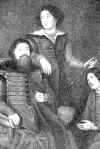 A
second example of an ambassadorial portrait shows the Boyar S. I. Prozorovskii and his
staff (a fourth member of the group, posed on the left of the ambassador, got cut off in
this reproduction of the picture). The anonymous English artist who painted the
picture in 1662 presumably was following convention in the grouping of the figures and
their gestures. We cannot know whether he faithfully reproduced the attire of his
subjects. If he did, then here we may already have some evidence of a move toward
western fashions, at least on the part of the junior members of the embassy. The
fact that they are beardless also may be signficant, although it is important to remember
that convention tended to dicatate that young men be portrayed without beards (even if
they were in fact old enough to have grown them).
A
second example of an ambassadorial portrait shows the Boyar S. I. Prozorovskii and his
staff (a fourth member of the group, posed on the left of the ambassador, got cut off in
this reproduction of the picture). The anonymous English artist who painted the
picture in 1662 presumably was following convention in the grouping of the figures and
their gestures. We cannot know whether he faithfully reproduced the attire of his
subjects. If he did, then here we may already have some evidence of a move toward
western fashions, at least on the part of the junior members of the embassy. The
fact that they are beardless also may be signficant, although it is important to remember
that convention tended to dicatate that young men be portrayed without beards (even if
they were in fact old enough to have grown them).
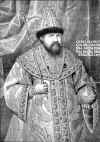 Even
though he was known for his Orthodox piety, Tsar Aleksei Mikhailovich had a broadly
ranging curiosity, actively sought Western books and news and displayed an interest in
Western culture. He hired a learned Belorussian monk, Simeon Polotskii, to tutor his
children, including his daughter Sofiia. That education included learning some Latin
and Polish. One son, Aleksei, who pre-deceased his father, accumulated quite an
extensive library, including many foreign books. It should not surprise us then to
find portraits of Aleksei Mikhailovich. Very likely he sat for portraits, although
none painted during his life are known to survive. The best-known example of his
portrait was probably painted posthumously ca. 1680. Unlike icons which were
painted with egg tempera on wood, it is painted in oils on canvas and may well be the
earliest Muscovite example of such a painting.
Even
though he was known for his Orthodox piety, Tsar Aleksei Mikhailovich had a broadly
ranging curiosity, actively sought Western books and news and displayed an interest in
Western culture. He hired a learned Belorussian monk, Simeon Polotskii, to tutor his
children, including his daughter Sofiia. That education included learning some Latin
and Polish. One son, Aleksei, who pre-deceased his father, accumulated quite an
extensive library, including many foreign books. It should not surprise us then to
find portraits of Aleksei Mikhailovich. Very likely he sat for portraits, although
none painted during his life are known to survive. The best-known example of his
portrait was probably painted posthumously ca. 1680. Unlike icons which were
painted with egg tempera on wood, it is painted in oils on canvas and may well be the
earliest Muscovite example of such a painting.
It seems to follow standard European conventions for a formal
portrait. The subject is shown in formal attire with the most important symbols of
his status and office (in this case, the orb and scepter with the double-headed eagle).
There is an inscription in Slavonic letters naming the tsar and listing his most
important titles. 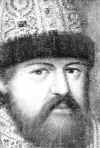 Significantly,
the image is termed an "obraz," the word that normally would designate
an "icon," not a parsuna or portrait. Part of the convention of
the seventeenth-century portraits was to fill otherwise empty spaces with the baroque
folds of a drapery, such as we have here in the upper left of the picture. Unlike in
the case above of the "portrait" of his son Fedor Alekseevich, this picture has
what we might term "normal," not iconographically stylized facial features.
However, aspects of the technique of the painting suggest it most likely was
executed by someone (or possibly a team of painters) trained in traditional icon painting.
Some feel that this painting may be the work of a Dutch artist who was at the
Muscovite court during Aleksei's reign, but the leading Russian expert on these early
portraits sees it as a product of the artists in the Moscow Armory, which was the most
important center of artistic production in the Kremlin at the time and the place where,
among others, the important icon painter Simeon Ushakov worked.
Significantly,
the image is termed an "obraz," the word that normally would designate
an "icon," not a parsuna or portrait. Part of the convention of
the seventeenth-century portraits was to fill otherwise empty spaces with the baroque
folds of a drapery, such as we have here in the upper left of the picture. Unlike in
the case above of the "portrait" of his son Fedor Alekseevich, this picture has
what we might term "normal," not iconographically stylized facial features.
However, aspects of the technique of the painting suggest it most likely was
executed by someone (or possibly a team of painters) trained in traditional icon painting.
Some feel that this painting may be the work of a Dutch artist who was at the
Muscovite court during Aleksei's reign, but the leading Russian expert on these early
portraits sees it as a product of the artists in the Moscow Armory, which was the most
important center of artistic production in the Kremlin at the time and the place where,
among others, the important icon painter Simeon Ushakov worked.
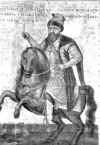
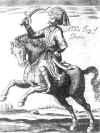 We also have a somewhat crudely
executed depiction of Aleksei Mikhailovich on horseback, probably painted earlier than the
foregoing portrait and unquestionably the work of an artist who was challenged by the
conventions of Western perspective. One can sense this easily by comparing the
picture with a contemporary engraving of the Persian Shah Abbas. The conventions of
the portrait of a mounted ruler on a rearing horse are observed in the Muscovite example,
but, significantly, the tsar bears a cross. One cannot help but be reminded of the icon of
the "Blessed Host," where Ivan IV (if indeed it is he), is shown bearing a cross
and wearing his royal robes rather than depicted in military garb and with weapons.
We also have a somewhat crudely
executed depiction of Aleksei Mikhailovich on horseback, probably painted earlier than the
foregoing portrait and unquestionably the work of an artist who was challenged by the
conventions of Western perspective. One can sense this easily by comparing the
picture with a contemporary engraving of the Persian Shah Abbas. The conventions of
the portrait of a mounted ruler on a rearing horse are observed in the Muscovite example,
but, significantly, the tsar bears a cross. One cannot help but be reminded of the icon of
the "Blessed Host," where Ivan IV (if indeed it is he), is shown bearing a cross
and wearing his royal robes rather than depicted in military garb and with weapons.
There is abundant evidence that well before the "westernizing"
reforms of Peter the Great (ruled 1682-1725; active reign begins ca. 1694), the court
elite in Muscovy had been acquiring at least the superficial trappings of "western
culture." We have already noted to ways in which those involved in diplomatic
activity might have been so influenced. Travel abroad was not necessary for such
exposure, given the increasing frequency of foreign embassies to Moscow and the growth of
the foreign presence in the "Foreign Quarter," which housed merchants and
families of foreign mercenaries. The Diplomatic Chancery became an important center
for the translation of foreign books, although their repertoire was rather limited and
their distribution even more so. One of the important sources of 'westernizing"
influence was Ukraine, which increasingly became the source of educated Orthodox clerics
for the Muscovite church. To a considerable degree what we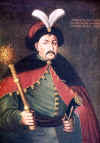
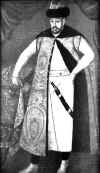 think of as "western" style was in fact Polish
fashion filtered through the Ukrainian elite. An example can be seen in the formal
portrait (left) of the famous Ukrainian cossack hetman, Bohdan Khmelnits'kyi, who led the
rebellion against Polish rule in Ukraine in 1648. He is shown with his mace of
office, with his cloak open to display the handle of a sword. The inscription
identifies him. A Polish portrait of Kryzstof Zbarazski, also from the mid-17th
century, provides a perhaps more conventional example of the portrait genre. He is
shown standing next to a table which serves as a prop. The tablecloth and his robe
are of expensive (very possibly Turkish) brocade. His long cape is pulled back to
show his sword. Baroque drapes fill the upper corners of the picture and an
inscription in Latin informs the viewer that he is the penipotentiary ambassador to the
Turks. Probably the portrait was painted to commemorate his appointment.
think of as "western" style was in fact Polish
fashion filtered through the Ukrainian elite. An example can be seen in the formal
portrait (left) of the famous Ukrainian cossack hetman, Bohdan Khmelnits'kyi, who led the
rebellion against Polish rule in Ukraine in 1648. He is shown with his mace of
office, with his cloak open to display the handle of a sword. The inscription
identifies him. A Polish portrait of Kryzstof Zbarazski, also from the mid-17th
century, provides a perhaps more conventional example of the portrait genre. He is
shown standing next to a table which serves as a prop. The tablecloth and his robe
are of expensive (very possibly Turkish) brocade. His long cape is pulled back to
show his sword. Baroque drapes fill the upper corners of the picture and an
inscription in Latin informs the viewer that he is the penipotentiary ambassador to the
Turks. Probably the portrait was painted to commemorate his appointment.
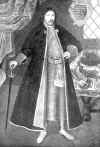 Clearly
the formal language of a portrait such as Zbarazski's was the language of portraits which
began to be painted at the Muscovite court in the last decade or so of the seventeenth
century, and there is every reason to believe that the Polish fashions of the subjects of
these portraits were what the individuals actually would wear. An example is the
portrait of the courtier V. F. Liutkin, painted in 1697, the year that the young tsar
Peter sent a group of courtiers abroad to study and himself departed for his foreign
tour. Liutkin is wearing Polish/Ukrainian clothes, displaying his weapon at his
belt, and standing next to a table with a brocaded table cloth. In one corner, we
see the standard baroque drape. The cartouche (frame) with the inscription
identifies the subject, with Latin script transliteration being used to render the
Russian. The painter apparently confused the direction of the letters "b"
and "d" (reversing them), which suggests he may not have been conversant with
the alphabet but knew merely it was de rigeur to use it for writing the
inscription. Liutkin's portrait would seem to tell us about the fact that cultural
change among the Muscovite elite was well underway, at least insofar as some matters of
taste and dress were concerned.
Clearly
the formal language of a portrait such as Zbarazski's was the language of portraits which
began to be painted at the Muscovite court in the last decade or so of the seventeenth
century, and there is every reason to believe that the Polish fashions of the subjects of
these portraits were what the individuals actually would wear. An example is the
portrait of the courtier V. F. Liutkin, painted in 1697, the year that the young tsar
Peter sent a group of courtiers abroad to study and himself departed for his foreign
tour. Liutkin is wearing Polish/Ukrainian clothes, displaying his weapon at his
belt, and standing next to a table with a brocaded table cloth. In one corner, we
see the standard baroque drape. The cartouche (frame) with the inscription
identifies the subject, with Latin script transliteration being used to render the
Russian. The painter apparently confused the direction of the letters "b"
and "d" (reversing them), which suggests he may not have been conversant with
the alphabet but knew merely it was de rigeur to use it for writing the
inscription. Liutkin's portrait would seem to tell us about the fact that cultural
change among the Muscovite elite was well underway, at least insofar as some matters of
taste and dress were concerned.
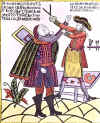 A
famous eighteenth-century woodcut depicting the cutting of an Old Believer's beard is
often taken as emblematic of Peter the Great's foreced westernization of Russia.
(Ironically, of course, the Old Believer is wearing Western clothing, an anomaly that
seems not to have struck the artist.) We should not let this image distort our
understanding of the cultural processes which had been evolving in Muscovy prior to Peter
or would continue during his reign and beyond. In fact, not all courtiers were any
longer devotees of their beards and traditional robes. When Peter selected
individuals to send abroad for practical training in 1697, he could draw upon courtiers
who had acquired some education from the Ukrainians and Belorussians in Moscow.
Courtiers such as Liutkin were affecting to write their names in their books in
Latin-alphabet transcription, and some of them were attracted not only by Polish dress but
by Polish models of writing which emphasized individuals' achievement and fame, rather
than traditional piety. One should not, however, equate such interests with a
rejection of traditional Muscovite values and the Orthodox faith, nor should one assume
that the taste for foreign culture was very widespread in Russian society. Even a
century and a half later, after generations of intense westernization of the Russian
elite, the impact of the West in rural Russia was minimal.
A
famous eighteenth-century woodcut depicting the cutting of an Old Believer's beard is
often taken as emblematic of Peter the Great's foreced westernization of Russia.
(Ironically, of course, the Old Believer is wearing Western clothing, an anomaly that
seems not to have struck the artist.) We should not let this image distort our
understanding of the cultural processes which had been evolving in Muscovy prior to Peter
or would continue during his reign and beyond. In fact, not all courtiers were any
longer devotees of their beards and traditional robes. When Peter selected
individuals to send abroad for practical training in 1697, he could draw upon courtiers
who had acquired some education from the Ukrainians and Belorussians in Moscow.
Courtiers such as Liutkin were affecting to write their names in their books in
Latin-alphabet transcription, and some of them were attracted not only by Polish dress but
by Polish models of writing which emphasized individuals' achievement and fame, rather
than traditional piety. One should not, however, equate such interests with a
rejection of traditional Muscovite values and the Orthodox faith, nor should one assume
that the taste for foreign culture was very widespread in Russian society. Even a
century and a half later, after generations of intense westernization of the Russian
elite, the impact of the West in rural Russia was minimal.
[Note: Much of the material here and many of the pictures come from
E. S. Ovchinnikova, Portret v russkom iskusstve XVII veka (Moscow, 1955).]
© 2000 Daniel C. Waugh
 We can
begin to speak of "icon-portraits" possibly by ca. 1600. While the
versions we have tend to be copies made no earlier than the end of the seventeenth
century, it is argued that they are based on originals which may have been painted not
long after the deaths of those depicted. One such example is an icon-portrait of
Tsar Fedor Ivanovich (the last of the Moscow branch of the Riurikids who died in 1598),
who was known for his piety and was venerated, if not actually canonized, as a
saint. The main thing which would distinguish him from an ascetic saint is his
jeweled collar. Otherwise, we see the typical iconographic facial features,
including stylized almond-shaped eyes, and a somewhat pinched, ascetic mouth.
We can
begin to speak of "icon-portraits" possibly by ca. 1600. While the
versions we have tend to be copies made no earlier than the end of the seventeenth
century, it is argued that they are based on originals which may have been painted not
long after the deaths of those depicted. One such example is an icon-portrait of
Tsar Fedor Ivanovich (the last of the Moscow branch of the Riurikids who died in 1598),
who was known for his piety and was venerated, if not actually canonized, as a
saint. The main thing which would distinguish him from an ascetic saint is his
jeweled collar. Otherwise, we see the typical iconographic facial features,
including stylized almond-shaped eyes, and a somewhat pinched, ascetic mouth.












